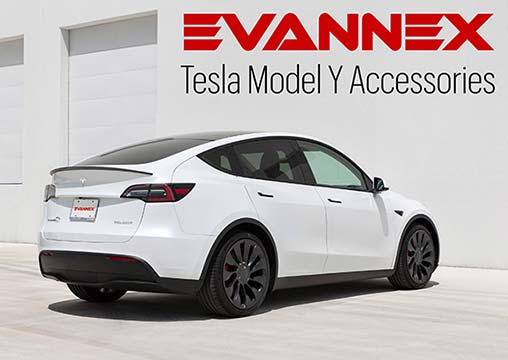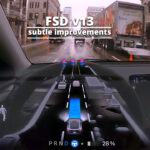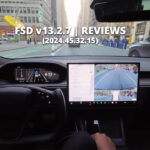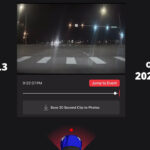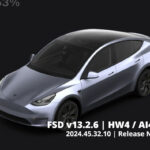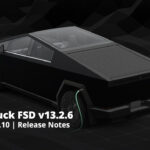Tesla has finally transitioned the FSD Beta software from the 2022 firmware branch to the 2023 branch. This has happened with the rollout start of the new FSD Beta v11.4 with the firmware version 2023.6.15.
Before this FSD Beta update, The majority of Tesla owners were on the 2023 branch and were unable to download FSD Beta since it was running on an older 2022 branch.
According to the Tesla firmware tracking website TeslaScope.com, Tesla cars running on versions 2023.2 and 2023.6 will be able to upgrade to FSD Beta v11.4 (2023.6.15).
With the passage of time, most Tesla owners in the United States and Canada will be on the same software branch with the option to try Tesla’s Full Self-Driving Beta.
Since this is a major subversion update (from 11.3.6 to 11.4), Tesla made a significant number of changes to its self-driving software. The release notes for FSD Beta v11.4 mention all these changes and improvements in detail.
Lane markings, lane handling, and driving on roads without lane markings have been the focus of the Tesla Autopilot AI team with the release of FSD Beta 11.4.
In our last review of FSD Beta 11.3.6, we saw that Tesla vehicles are now able to create a safe distance between them while passing a large truck or vehicle. While some FSD Beta testers found this feature very useful in various scenarios, a large number of users reported having problems and safety issues as the car swerved to the other side of the road.
“I spoke too soon about beta 11.3.6. Drove 500+ miles last week. FSD still sends me into HOV lane when opted out, and veers to lane markings without big trucks next to me, at times literally driving on lane markings dangerously close to cars in the adjacent lane,” wrote Tesa Joy on Twitter, a long time FSD Beta tester.
Multiple other FSD Beta testers also reported similar Tesla Autopilot behavior which is potentially dangerous. Tesla seems to have focused on this issue in version 11.4. The net effect of the improvements will only be determined when this new version is extensively tested. But the release notes seem promising to have fixed multiple issues.
Tesla once again shifted its focus to vulnerable road users (VRUs/pedestrians, bicycles, pets, etc.) in the FSD Beta v11.4 update. Points #1 & 2 in the release notes discuss improvements in the detection of pedestrians on crosswalks and the probability of them coming in the path of the ego (referred to the car’s AI self, there is one ego for all Teslas running on FSD Beta).
FSD Beta v11.4 (2023.6.15) Release Notes
- Improved the decision to assert or yield for pedestrians at more crosswalks by evaluating multiple possible futures in the joint space of ego’s actions and the pedestrian’s response
- Improved ego’s behavior near VRUs by measuring their probability of intersecting ego’s path, based on their kinematic data, and preemptively decelerating when the estimated risk is high.
- Improved turn performance in dense unstructured city environments. Examples of improved cases include: turning when the turn lane is blocked by parked cars and avoiding turning into bus lanes.
- Improved lane guidance module to feed in long-range routing “hints” to the network for which lanes ego needs to be in to reach its destination. Also significantly improved pre-lane routing type autolabeler. These changes combined resolved 64% of all interventions caused by bad routing type.
- Improved geometric consistency between lane, line, road edge, and restricted space detections by re-training our networks on the same dataset with the latest version of our “lane guidance” module, and by using a common features space to predict line, road edge, and restricted space.
- Improved recall for partial cut-ins y 39% and precision for false positive cut-ins due to lane changes into adjacent lanes by 66%, resulting in a 33% reduction in overall lane-changing prediction error. This was accomplished by further increasing our auto-labeled fleet dataset by 80k clips, improving the accuracy of the auto-labeling algorithm, and tuning the distribution of training supervision.
- Improved understanding for when to use bus lanes and when to avoid them by updating the lane type detection network and improving map-vision fusion.
- Improved speed control during lane changes through better consideration of upcoming navigation deadlines, required back-to-back lane changes and presence of a vehicle behind ego.
- Added new Vision Speed network to infer the typical driving speed on a given road. This is used to limit the maximum allowed speed in environments such as parking lots and residential roads.
- Mitigated hydroplaning risk by making maximum allowable speed in Autopilot proportional to the severity of the detected road conditions. In extreme cases, Autopilot may use the wetness of the road, tire spray from other vehicles, rain intensity, tire wear estimation or other risk factors that indicate the vehicle is near the handling limit of the surface to warn the driver and reduce speed.
- Improved long-range path blockage detection and control on city streets. Ego will now be able to perform lane changes due to upcoming path blockages earlier.
- Improved developer productivity with better code diagnostics and C++20 features by upgrading compiler to clang-16. This also improved photon-to-control vehicle response latency by 2%.
Stay tuned for constant Tesla updates, follow us on:
Google News | Flipboard | X (Twitter) | WhatsApp Channel | RSS (Feedly).
Related
- Tesla FSD v13 beta tester marks subtle but significant improvements in the latest versions
- A glimpse of Unsupervised FSD, watch Tesla owner eat as her car drives itself on Autopilot
- Tesla FSD v13.2.7 (2024.45.32.15) rollout gets wider (review videos)
- FSD v12.6.3 is the best version for HW3/AI3 Tesla cars yet (review videos)
- Tesla’s AI4 Model S, 3, X, and Y get the new FSD v13.2.6 OTA update (Release Notes)
- Tesla pushes Cybertruck FSD v13.2.6 with new improvements and teases upcoming ones (Release Notes)

